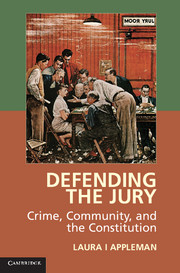Book contents
- Frontmatter
- Contents
- Acknowledgments
- 1 Introduction
- Part I History in the Crucible: Rediscovering the Original Community Right in Criminal Justice
- Part II Old Becomes New: Sixth Amendment Jury Rights and Twenty-First-Century Criminal Procedure
- 4 Retribution, Restorative Justice, and the Sixth Amendment Jury Right
- 5 Defining Community in the Twenty-First Century: Cities, Counties, and Collective Action
- Part III Theory into Practice: Origins and Community in Modern Criminal Procedure
- Selected Bibliography
- Index
- References
5 - Defining Community in the Twenty-First Century: Cities, Counties, and Collective Action
Published online by Cambridge University Press: 05 April 2015
- Frontmatter
- Contents
- Acknowledgments
- 1 Introduction
- Part I History in the Crucible: Rediscovering the Original Community Right in Criminal Justice
- Part II Old Becomes New: Sixth Amendment Jury Rights and Twenty-First-Century Criminal Procedure
- 4 Retribution, Restorative Justice, and the Sixth Amendment Jury Right
- 5 Defining Community in the Twenty-First Century: Cities, Counties, and Collective Action
- Part III Theory into Practice: Origins and Community in Modern Criminal Procedure
- Selected Bibliography
- Index
- References
Summary
What does it mean to be part of a community? In the twenty-first-century digital world, this is a difficult question. Though used routinely within the world of criminal justice, the term “community” has been underinvestigated. The greater significance, the wider scope, and the broader meaning of the term community have remained unexplored. In response, this chapter evaluates the various meanings and understandings of the community as it exists today.
The criminal jury setting has long defined notions of “the community” in geographical and corporeal terms, focusing on the local, physically present peers of the defendant as the community’s primary representative. However, in the modern world, which now has both multiple overlapping online communities (ranging from Facebook to Twitter to Instagram) as well as online crimes, the notion of “community rights” and the means of incorporating the community into criminal justice decision-making needs to be premised on more than traditional conceptions of the community. Accordingly, Chapter 5 charts the various forms that community can take in today’s criminal justice system, discussing the various problems that can arise from relying on a modern, amorphous “community” to dispense justice.
Generally, those who argue that the community has a right and a need to participate in all major criminal justice procedures assume that the community is a defined entity. The phrase “the community,” however, can mean a variety of things, often simultaneously. It is thismultiplicity of meaning that I seek to explore throughout the rest of this chapter.
- Type
- Chapter
- Information
- Defending the JuryCrime, Community, and the Constitution, pp. 70 - 88Publisher: Cambridge University PressPrint publication year: 2015



